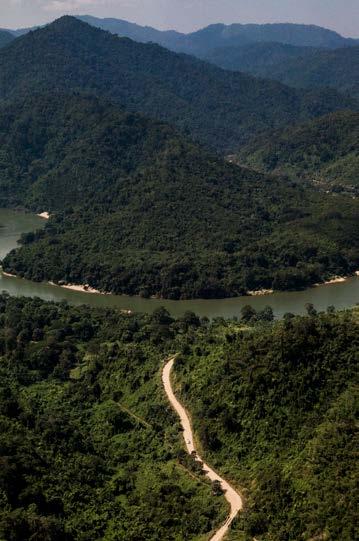
6 minute read
Sustainable Infrastructure
programmes SUSTAINABLE INFRASTRUCTURE
Myanmar is at a critical point in its development, with foreign investments in infrastructure potentially jeopardising the country’s pristine ecosystems and the communities and threatened species they sustain.
Advertisement
WWF-Myanmar’s sustainable infrastructure programme has been able to provide thought leadership, institutionalise thinking around sustainable infrastructure and build capacity for real change by collaborating on a common vision for sustainable infrastructure in Myanmar with the country’s leadership.
We have built strategic relationships in various non-environment ministries like the Ministry of Construction, Ministry of Transport and Communications and the Ministry of Finance and Planning. The enthusiasm and demand for infrastructure planning support from the Ministry of Construction has been demonstrated through their ownership and involvement in the development of the Diploma Course on Transport Ecology. These measures will eventually drive systemic change and that can protect Myanmar’s globally-significant forest landscapes. Economic recovery post COVID-19 offers a unique opportunity to focus on the root causes of the current crisis, as well as a strong role for WWF to advocate for measures that speed up the transition to mainstreaming nature-based solutions in infrastructure planning. There is scope to change the rules of the game and promote an increased focus on investing in nature for resilience.
October 2019
KEY GOVERNMENT OFFICIALS TRAINED in Environmental Impact Assessments (EIA), including individuals from the Ministry of Construction, Ministry of Transport and Communications, and later the Ministry of Natural Resources and Environmental Conservation
November 2019
MOU SIGNED with the Ministry of Construction outlining collaboration on developing expertise on transport ecology within the ministry, and transforming road projects into inspiring examples of sustainable infrastructure
December 2019
FIVE YEARS OF EVIDENCEBASED ADVOCACY RESULT IN WWF’s detailed recommendations to reduce the Dawei Road’s impact on biodiversity and wildlife being endorsed by the Ministry of Construction in Myanmar and the project developer, NEDA
OUR NEXT STEPS
2020-1 Launch Myanmar’s first ever transport ecology Diploma course for engineers, planners and technocrats
2020-1 Conduct first ever training and workshop on Rail Ecology for the Myanma Railways and identify pilots projects

2021 Mainstream nature-based solutions in sustainable infrastructure planning as part of COVID-19 recovery planning
2021 Revolutionise the practice of corridor mapping by making it accessible to non-technical users such as government decision makers by launching a web based app that helps plan linear infrastructure across key wildlife habitats “OUR BIGGEST ACHIEVEMENT IS THE RECOGNITION THAT WHERE WE LOCATE INFRASTRUCTURE DETERMINES THE BENEFITS AND IMPACTS TO PEOPLE AND NATURE. OUR MISSION IS NOW TO INSTITUTIONALISE RESILIENCE AND SUSTAINABILITY IN INFRASTRUCTURE PLANNING.”
Urvana Menon Programme Manager
February 2020
NEW PARTNERSHIP FORMED with the Ministry of Transport and Communications with specific focus on incorporating environmental and ecological safeguards in transport planning policy frameworks
February 2020
FIRST-EVER DIPLOMA COURSE on Transport Ecology goes into development, led by the Ministry of Construction and Yangon Technical University with support and initiative from WWF. The course will train officials, engineers, planners and other professionals from the government and academic institutions
Q&A
Sustainable Infrastructure Programme Officer, Sai, tells us more about the MoU signed with with Myanmar’s Minisry of Construction in 2019.
My name is Sai Than Lwin and I work with WWF-Myanmar as a Sustainable Programme Officer. My role is to support the programme by working with partners and the government to collect and analyse crucial data on infrastructure and its impacts on wildlife and the environment. We also raise awareness and understanding of the broad range of ecological issues related to transport infrastructure. Our goal is to ensure that sustainability is at the forefront of conversations on infrastructure development.
We’re here to talk about the MoU signed between Myanmar’s Ministry of Construction and WWF-Myanmar - and its significance. First off, can you first tell us what an MoU is?
So a Memorandum of Understanding is a signed agreement between two or more parties, expressing a convergence of will or intended common line of action. In this case the MoU is between the Ministry of Construction, who is developing roads and bridges to enhance social economy for the country’s development, and WWF Myanmar, to collaborate actively to implement sustainable transport infrastructure development in Myanmar.
What’s the significance of the signing of this MoU, for people and nature?
This collaboration is really exciting, and I believe that it will lay the ground for Myanmar to become a global leader in sustainable infrastructure development. It’s a critical step toward enabling the Ministry of Construction to play an important role in conserving the country’s rich biodiversity whilst ensuring sustainable development - one of our government’s top priorities.
And what does that mean for Myanmar’s people and nature?
With such vast areas of undeveloped land, there are going to be lots of infrastructure projects in Myanmar’s future, and these roads are critical to the country’s economic development. The thing is, we already know from lessons learned in other countries across the world that if we don’t incorporate biodiversity and environmental conservation in upstream planning, the long term maintenance costs and impacts to ecosystem services end up hurting the economy negatively in the future.
The good news is that the signing of this MoU demonstrates the government’s commitment to sustainable development and a willingness to collaborate with conservation organisations like WWF.
Why is this MoU such a big deal?
As a conservation organisation, WWF normally signs MoUs with conservation departments, but this MoU with the infrastructure implementation and development department illustrates that both parties are eager to work together for conservation and socioeconomic development.
Is this something you’ve been working toward for a long time?
We’ve been working with the Ministry of Construction toward the signing of the MoU for a long time - and they were actively helping us to make this happen. It was a long process, but it has been worth it.
Tell us about the day the MoU was signed?
The trickiest part was finding a date for the signing ceremony! The
Director General of the Department of Highways and WWF’s country director are very busy. Anyway we finally landed on 14th November, 2019. When the day came, the Director General was waiting for us along with the Chief Engineers. He spoke frankly about how he felt, and what he had learned on a trip to the US for the International Conference on Ecology and Transportation - especially of the site visits they made to see wildlife mitigation measures such as wildlife crossings.
He spoke of how the MoU would help the ministry to raise awareness of the need to nature for people and wildlife within the department, and he wrapped up his speech highlighting the importance that these messages reach the public, saying that the department would be willing to help ensure that happened. The department seems very excited, and keen to learn new technologies that could enhance their knowledge to become one of the sustainable development leaders in the region. WWF feels the same, so that day was a huge moment for us all.
On a personal level, how did you feel that day?
It was so exciting to see the very first steps of my government, especially the engineering/planning people, showing that they would like to develop the infrastructure in sustainable ways without destroying nature. It was an honor to talk at length with the Director General as we discussed the importance of ecosystem services and infrastructure and shared our past experiences. He even said that he would like to share the knowledge with other related departments such as the Department of Rural Roads.
So what’s next?
Sustainable infrastructure has become one of Asia’s hot topics. Myanmar’s geological advantage - sitting between two Asia giants, China and India, and with neighbours Thailand, Laos and Bangladesh - means that infrastructure development is a must, and essential for socio-economic development. This MoU will play an important role going forward, reminding the government to be cautious when planning, and it will help us all to work toward our shared goals to develop sustainable infrastructure, along with Myanmar’s sustainable development plan.
© Hkun Lat/WWF-Myanmar




